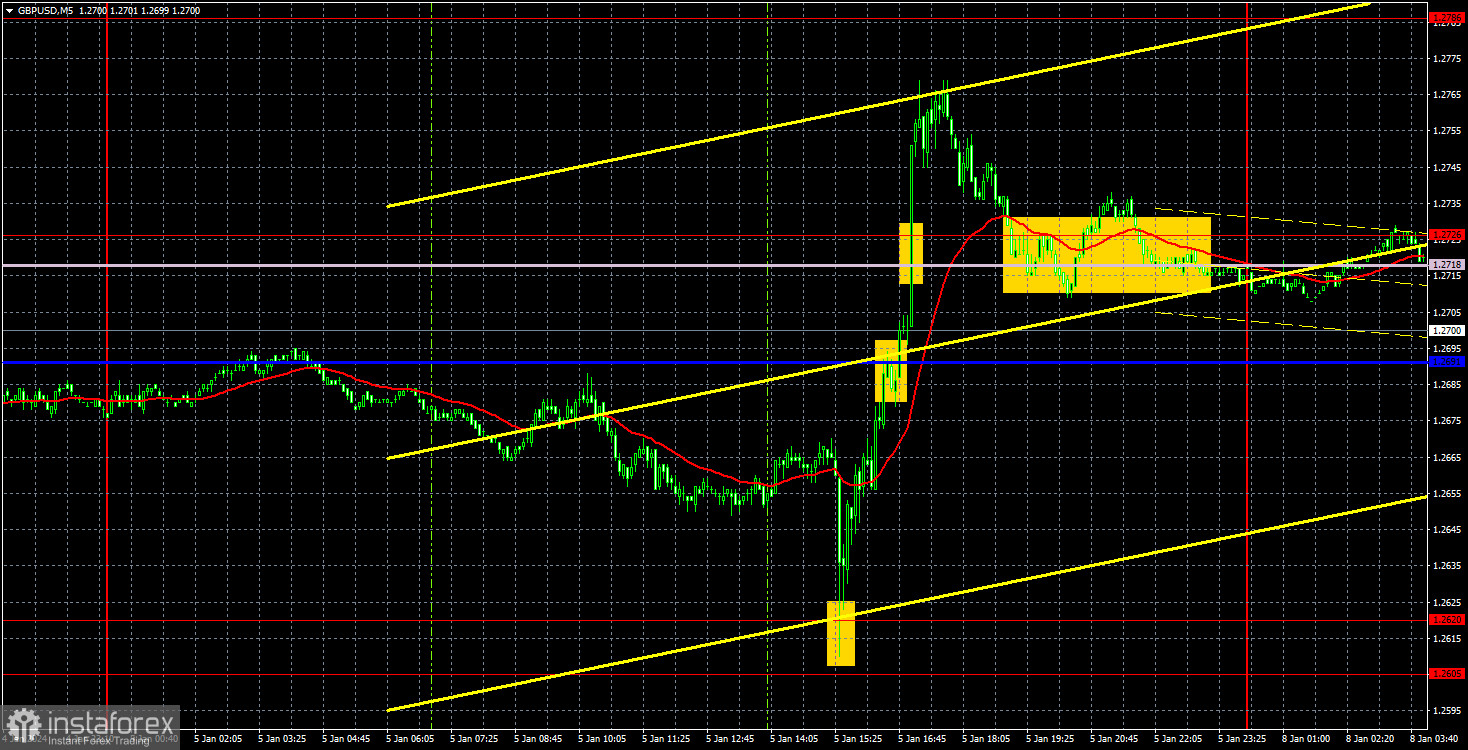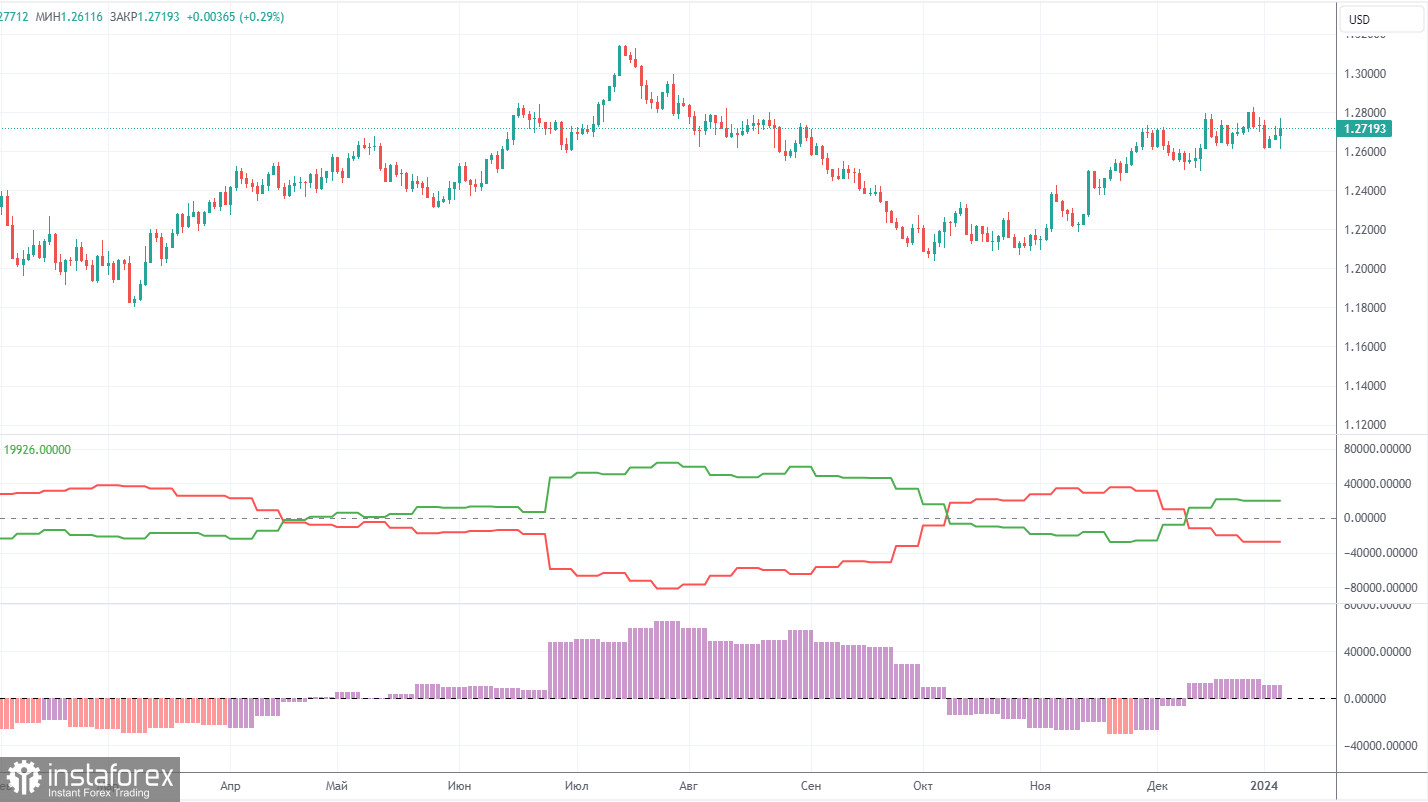Analysis of GBP/USD 5M

GBP/USD traded higher on Friday. The price did not breach the level of 1.2620, and if we look at the technical picture over the last two to three weeks, it becomes clear that the pound has entered a sideways channel between 1.2620 and 1.2786. Thus, the Ichimoku indicator lines are losing their strength at the moment, and the price could continue to fluctuate within the channel's boundaries for another couple of weeks. The fact is the market is still not looking downward, so regardless of the reports, we won't see a fall in the pound anytime soon.
On Friday, there were plenty of reasons to buy the dollar. The U.S. labor market and unemployment data turned out to be good, but market participants (as they like to do) found a drawback, so instead of a logical rise from the dollar, we saw an illogical rise of the pound again. Take note that the U.S. ISM Business Activity Index for the services sector turned out to be weaker than expected, which could have triggered the dollar's fall. But why did the dollar fall when half of the reports are positive and half are negative?
At this point, we can say only one thing: even if it is necessary for the price to fall for technical reasons, despite a good macroeconomic background, the pair cannot start a downward movement. Therefore, all we can do is monitor the technical picture and react to changes in market sentiment.
Speaking of trading signals, they were fairly decent. The first buy signal in the form of a rebound from the level of 1.2620 was essentially the only one. The price crossed the Kijun-sen lines, Senkou Span B, and the level of 1.2726, after which the upward movement came to an end. The trade could have been closed around the level of 1.2726 when the price returned to it. The profit amounted to about 90 pips.
COT report:

COT reports on the British pound show that the sentiment of commercial traders has been changing quite frequently in recent months. The red and green lines, representing the net positions of commercial and non-commercial traders, often intersect and, in most cases, are close to the zero mark. According to the latest report on the British pound, the non-commercial group opened 3,000 buy contracts and 1,900 short ones. As a result, the net position of non-commercial traders increased by 1,100 contracts in a week. Since bulls currently don't have the advantage, we believe that the pound will not be able to sustain the upward movement for a long time. The fundamental backdrop still does not provide a basis for long-term purchases on the pound.
The non-commercial group currently has a total of 58,800 buy contracts and 46,600 sell contracts. Since the COT reports cannot make an accurate forecast of the market's behavior at the moment, and the fundamentals are practically the same for both currencies, we can only rely on technical analysis and economic reports. The technical analysis suggests that we can expect a strong decline (but there are no clear sell signals yet), and the economic reports have also been significantly stronger in the United States than in the United Kingdom for quite some time now, which does not provide any dividends for the dollar.
Analysis of GBP/USD 1H

On the 1H chart, GBP/USD is not even trying to move downwards; it is already in a fairly wide sideways channel. We believe that the British pound doesn't have any good reason to strengthen in the long-term. Therefore, at the very least, we expect the pair to return to the level of 1.2513. Currently, we haven't seen a breakthrough of the important range 1.2605-1.2620, so it is quite difficult to count on a prolonged downtrend for now.
Today, from a technical perspective, the pair may recommence the downward movement. The price needs to settle below the critical line, afterwards, it may even return to the 1.2605-1.2620 area. However, volatility may be relatively low, as is often the case on Mondays. We believe that the price will gradually fall. You can consider long positions if the price consolidates above 1.2726 using 1.2786 as a target.
As of January 8, we highlight the following important levels: 1.2215, 1.2269, 1.2349, 1.2429-1.2445, 1.2513, 1.2605-1.2620, 1.2726, 1.2786, 1.2863, 1.2981-1.2987. The Senkou Span B (1.2718) and Kijun-sen (1.2691) lines can also serve as sources of signals. Don't forget to set a breakeven Stop Loss to breakeven if the price has moved in the intended direction by 20 pips. The Ichimoku indicator lines may move during the day, so this should be taken into account when determining trading signals.
On Monday, there are no significant reports or events lined up in either the UK or the US. Therefore, we will rely on technical analysis, and volatility may be low.
Description of the chart:
Support and resistance levels are thick red lines near which the trend may end. They do not provide trading signals;
The Kijun-sen and Senkou Span B lines are the lines of the Ichimoku indicator, plotted to the 1H timeframe from the 4H one. They provide trading signals;
Extreme levels are thin red lines from which the price bounced earlier. They provide trading signals;
Yellow lines are trend lines, trend channels, and any other technical patterns;
Indicator 1 on the COT charts is the net position size for each category of traders;
Indicator 2 on the COT charts is the net position size for the Non-commercial group.





















